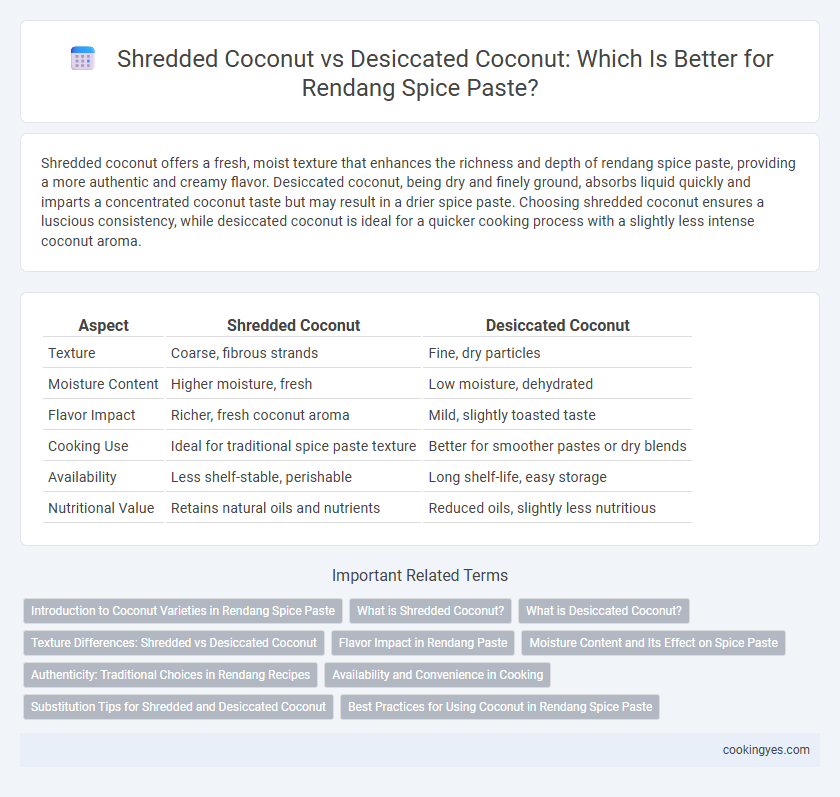Shredded coconut offers a fresh, moist texture that enhances the richness and depth of rendang spice paste, providing a more authentic and creamy flavor. Desiccated coconut, being dry and finely ground, absorbs liquid quickly and imparts a concentrated coconut taste but may result in a drier spice paste. Choosing shredded coconut ensures a luscious consistency, while desiccated coconut is ideal for a quicker cooking process with a slightly less intense coconut aroma.
Table of Comparison
| Aspect | Shredded Coconut | Desiccated Coconut |
|---|---|---|
| Texture | Coarse, fibrous strands | Fine, dry particles |
| Moisture Content | Higher moisture, fresh | Low moisture, dehydrated |
| Flavor Impact | Richer, fresh coconut aroma | Mild, slightly toasted taste |
| Cooking Use | Ideal for traditional spice paste texture | Better for smoother pastes or dry blends |
| Availability | Less shelf-stable, perishable | Long shelf-life, easy storage |
| Nutritional Value | Retains natural oils and nutrients | Reduced oils, slightly less nutritious |
Introduction to Coconut Varieties in Rendang Spice Paste
Shredded coconut and desiccated coconut differ significantly in texture and moisture content, impacting the flavor profile of Rendang spice paste. Shredded coconut is coarser and retains more moisture, lending a richer, creamier texture to the paste, whereas desiccated coconut is finely grated and dried, offering concentrated coconut flavor with a drier consistency. Choosing between these coconut varieties influences the depth and authenticity of Rendang's signature aroma and taste.
What is Shredded Coconut?
Shredded coconut is fresh coconut meat that has been grated into long, thin strips, preserving its natural moisture and rich flavor, making it ideal for creating authentic spice pastes in rendang. Unlike desiccated coconut, which is dried and has a reduced moisture content, shredded coconut retains more oil and texture, enhancing the depth and creaminess of the rendang paste. Using shredded coconut in the spice paste contributes to a more aromatic and traditional flavor profile, crucial for the slow-cooked complexity of rendang.
What is Desiccated Coconut?
Desiccated coconut is finely grated, dried coconut flesh that contains very low moisture content, making it ideal for spice pastes in Rendang due to its longer shelf life and consistent texture. Unlike shredded coconut, desiccated coconut absorbs liquids more readily, allowing the spice paste to thicken evenly and blend seamlessly with other ingredients. Its ability to release natural oils when toasted enhances the rich, aromatic profile essential to authentic Rendang flavors.
Texture Differences: Shredded vs Desiccated Coconut
Shredded coconut delivers a coarser, fibrous texture that adds a chewy bite to Rendang spice paste, enhancing mouthfeel with natural moisture retention. Desiccated coconut, being finely grated and dried, creates a smoother, drier paste that blends more uniformly, intensifying the spice dispersion without altering thickness significantly. Texture choice between shredded and desiccated coconut directly influences the Rendang's consistency and the balance of its rich, aromatic flavor profile.
Flavor Impact in Rendang Paste
Shredded coconut in Rendang spice paste provides a richer, creamier texture and imparts a deeper, natural sweetness compared to desiccated coconut, which is drier and less flavorful. The moisture content in shredded coconut enhances the paste's ability to blend spices, resulting in a more cohesive and aromatic Rendang sauce. Using shredded coconut intensifies the traditional savory and nutty notes crucial to authentic Rendang flavor profiles.
Moisture Content and Its Effect on Spice Paste
Shredded coconut contains higher moisture content compared to desiccated coconut, which impacts the texture and consistency of Rendang spice paste by making it thicker and more pliable. The moisture in shredded coconut aids in releasing natural oils during cooking, enhancing the richness and depth of flavors in the spice paste. Desiccated coconut's low moisture content results in a drier paste, requiring additional liquid to achieve the desired consistency, potentially altering the traditional Rendang's aromatic profile.
Authenticity: Traditional Choices in Rendang Recipes
Shredded coconut preserves the authentic texture and flavor of traditional rendang spice paste, as it is less processed and retains natural oils essential for depth and richness. Desiccated coconut, being dried and finely ground, lacks the robust aroma and slightly chewy texture integral to classic rendang preparations. Authentic rendang recipes typically favor freshly shredded coconut to maintain genuine taste and cultural heritage.
Availability and Convenience in Cooking
Shredded coconut offers a fresher texture but is less shelf-stable and harder to source outside tropical regions, making it less convenient for consistent use in rendang spice paste. Desiccated coconut, widely available in grocery stores worldwide, provides long shelf life and ease of storage, enabling reliable preparation of rendang spice paste anytime. Choosing desiccated coconut enhances convenience without compromising the rich, authentic flavor crucial for rendang dishes.
Substitution Tips for Shredded and Desiccated Coconut
Shredded coconut offers a moist texture and rich coconut flavor that enhances rendang's spice paste, while desiccated coconut provides a drier, more concentrated taste ideal when moisture content needs control. To substitute shredded coconut with desiccated, soak the desiccated version in warm water for 10-15 minutes to rehydrate and approximate the shredded coconut's texture and moisture. Adjust the liquid in the recipe accordingly to maintain the balance of flavors and consistency in the spice paste.
Best Practices for Using Coconut in Rendang Spice Paste
Shredded coconut retains more natural oil and moisture, enhancing the Rendang spice paste's richness and depth of flavor. Desiccated coconut, being drier, requires soaking or frying to release its oils and aroma, which can intensify the paste but may alter texture. Using freshly shredded coconut is best practice for authentic, aromatic Rendang, while desiccated coconut offers convenience when fresh options are unavailable.
Shredded coconut vs desiccated coconut for spice paste Infographic

 cookingyes.com
cookingyes.com